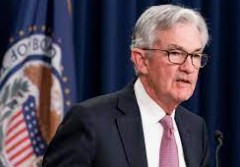


Federal Reserve policymakers voted on Dec. 14 to raise the benchmark federal funds rate by 50 basis points to a target range of 4.25–4.5 percent, the highest level since late 2007.
The Fed’s policy-making arm, the Federal Open Market Committee (FOMC), has boosted interest rates seven times since March, totaling 425 basis points.
During a post-meeting press conference, Fed Chair Jerome Powell said there’s still a long way to go in the fight against inflation. Most officials now anticipate raising rates above 5 percent next year, which is higher than previously projected.
“I wouldn’t see us considering rate cuts until the committee is confident that inflation is moving down to 2 percent in a sustained way,” Powell said.
In order to establish the pace of rate hikes, the central bank will look at cumulative tightening, economic and financial developments, and policy lags.
“Recent indicators point to modest growth in spending and production. Job gains have been robust in recent months, and the unemployment rate has remained low. Inflation remains elevated, reflecting supply and demand imbalances related to the pandemic, higher food and energy prices, and broader price pressures,” the FOMC said in a statement.
“Russia’s war against Ukraine is causing tremendous human and economic hardship. The war and related events are contributing to upward pressure on inflation and are weighing on global economic activity. The committee is highly attentive to inflation risks.”
Each FOMC member voted for the December monetary policy action. The decision indicates a deceleration from the 75 basis-point pace observed in the four prior meetings.
“Of course, 50 basis points is still a historically large increase, and we still have some ways to go,” Powell said.
The FOMC also released the dot plot, a chart that records every Fed official’s projection for interest rates.
The central bank expects that interest rates will climb to 5.1 percent in 2023, up from 4.6 percent in September forecasts. The officials anticipate median interest rates to ease to 4.1 percent in 2024 and 3.1 percent in 2025. The fed funds rate will then slow to 2.5 percent.
Despite market expectations for a “dovish pivot” in response to a better-than-expected November inflation report, the Fed stayed the course and maintained its hawkish message, according to Scott Anderson, chief economist at Bank of the West.
“This hawkish median dot plot, if realized, does keep the risk of a recession for the U.S. economy next year at an elevated level,” he wrote in an email.
According to the Fed’s Summary of Economic Projections (pdf), board members forecast that inflation will fall to around 2 percent by 2025.
The U.S. economy will expand just 0.5 percent in 2023, down from 1.2 percent in the September projection. The gross domestic product will also advance by 1.6 percent in 2024 and 1.8 percent in 2025. The median unemployment rate is seen rising to 4.6 percent in 2023 and 2024 and dipping slightly to 4.5 percent in 2025.
Financial markets erased their gains following the announcement, with all three leading benchmark indexes ending in the red.
The slowing inflation rate and strong jobs growth are giving the Fed enough ammunition to continue to tighten without worrying about triggering a recession, according to Mikhail Kouliavtsev, chair of the department of economics and finance at Stephen F. Austin State University.
“On the one hand, this gives the Fed a green[er] light to continue to fight inflation without fearing an immediate onset of a recession; on the other hand, strong wage growth is part of the problem: the so-called inflationary spiral is the cycle of rising wages, increased spending, upward pressure on prices, the need to adjust wages, and so on,” he wrote in a report.
At the same time, Ralph Axel, longtime interest-rate strategist at Bank of America, believes there will be multiple Fed pivots.
“We think markets have become too complacent about how simple the trajectory of the Fed, and, therefore, of markets, will be,” Axel said in a note. “The current market view is that it’s a single battle and once victory is declared, the game is over.”
This decision comes after the Bureau of Labor Statistics reported that the annual inflation rate eased to 7.1 percent in November, while the core inflation rate slowed to 6 percent. Looking ahead to the December Consumer Price Index, the Federal Reserve Bank of Cleveland’s Inflation Nowcast model suggests a reading of 6.8 percent.
Eric Peters, CEO of One River Asset Management, doesn’t believe the odds are in the Fed’s favor to bring the benchmark rate anywhere near 2 percent.
“We’re probably moving to an environment where inflation is between 3, 4, or 5 percent. Sometimes it goes a bit higher, sometimes it goes a little bit lower, but when you look at previous periods of higher inflation, they also have a lot of inflation volatility. So that’s what we need to live through right now,” Peters recently told Magnifi+, an AI-investing and trading platform.